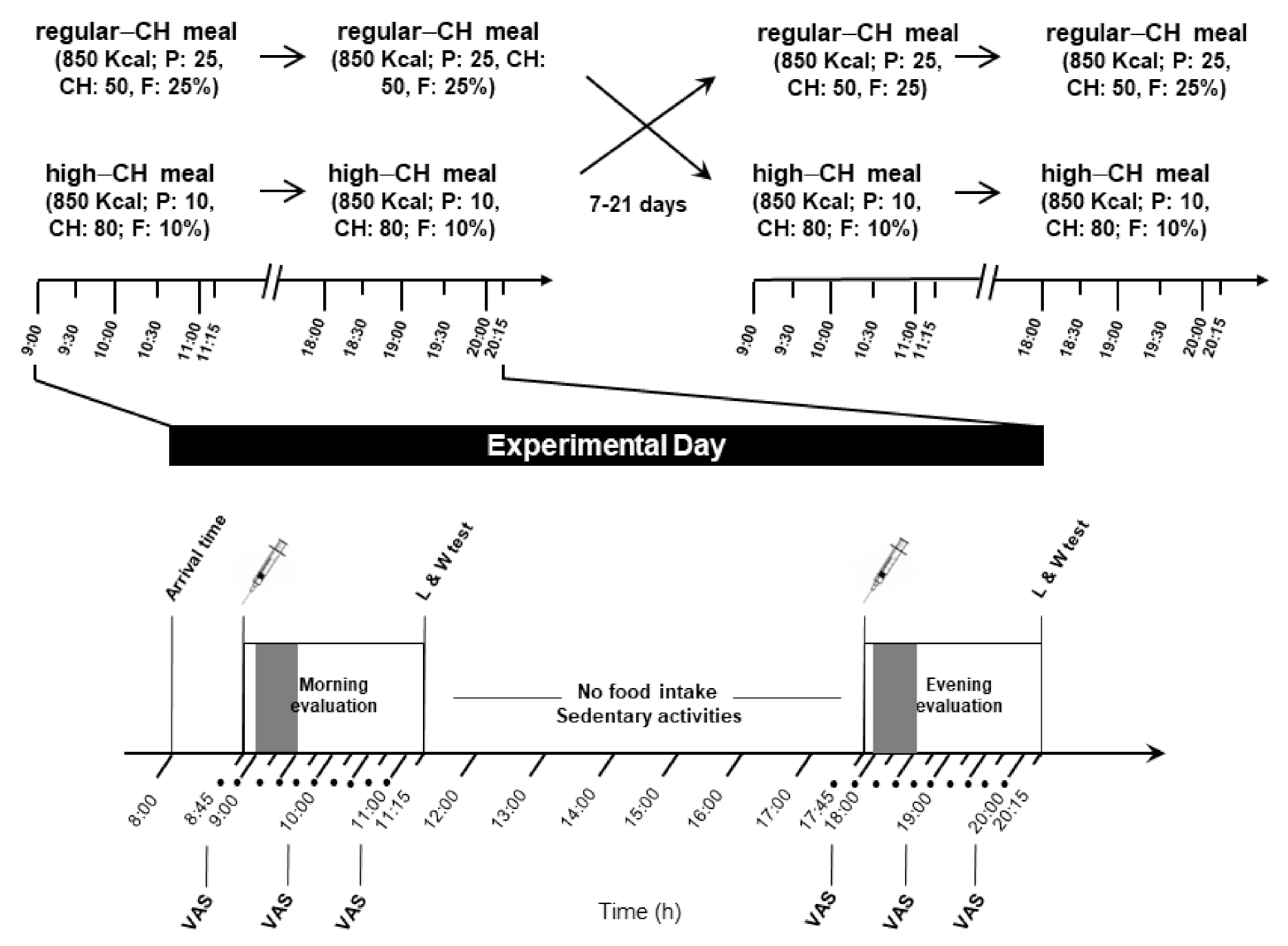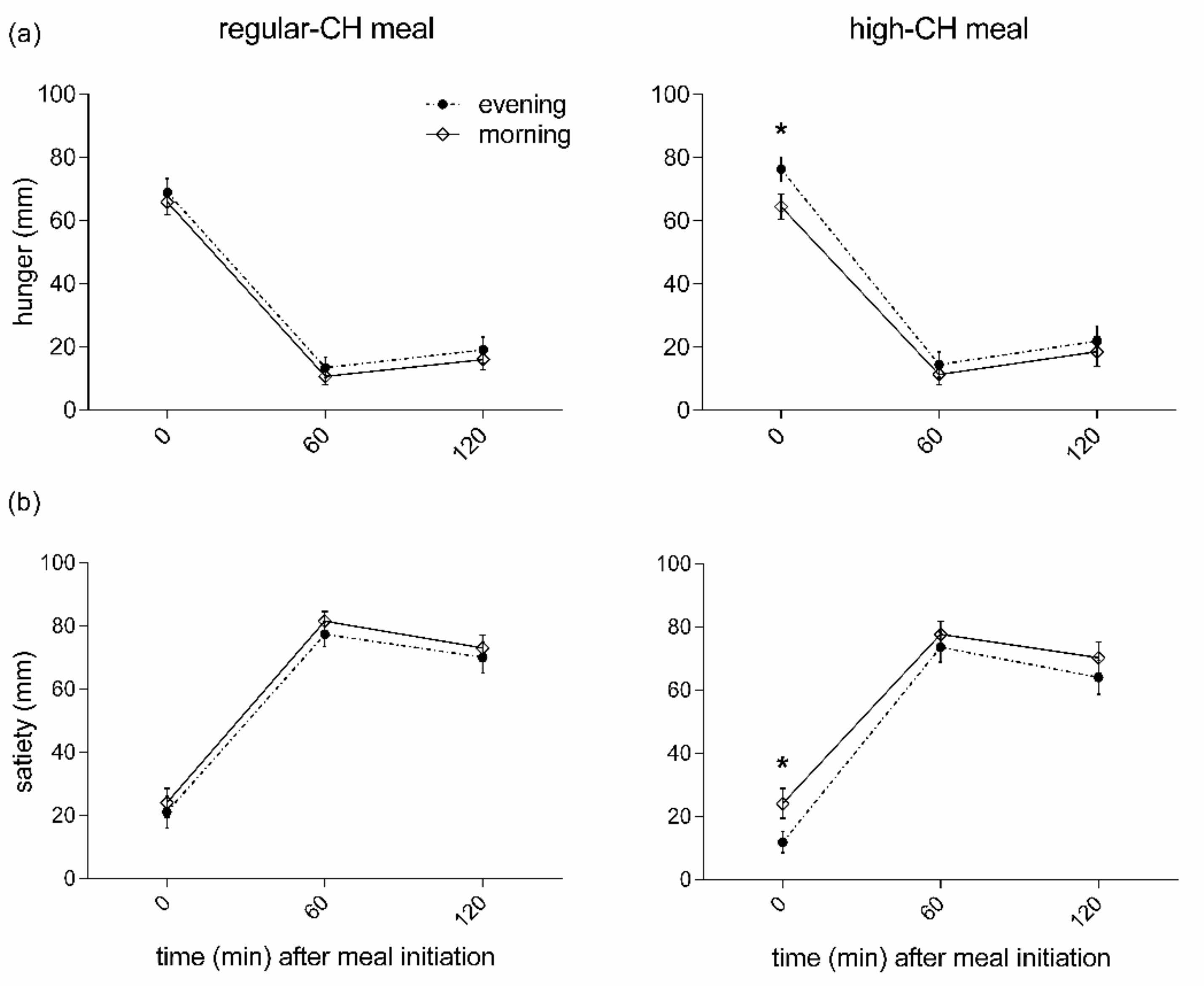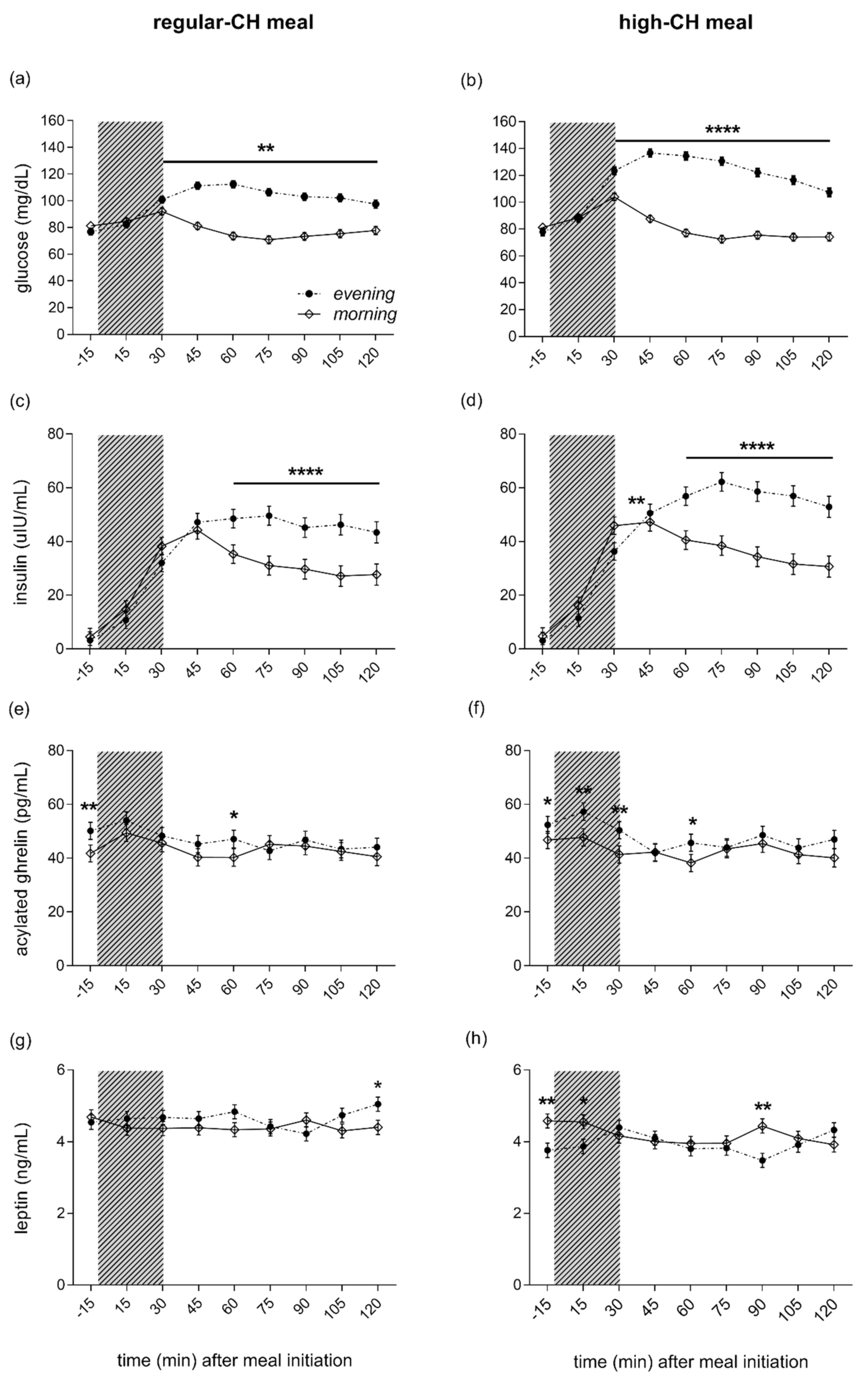Meal Timing and Macronutrient Composition Modulate Human Metabolism and Reward-Related Drive to Eat
Abstract
:1. Introduction
2. Materials and Methods
2.1. Study 1
2.2. Study 2
2.3. Experimental Procedures
2.4. Meals
2.5. Feelings of Hunger and Appetite
2.6. Hedonic and Homeostatic Drive to Eat
2.7. Blood Parameters
2.8. Statistical Analyses
3. Results
3.1. Study 1
3.2. Study 2
3.2.1. Subjective Feelings of Hunger and Satiety
3.2.2. Homeostatic and Hedonic Drive to Eat
3.2.3. Glucose Homeostasis
3.2.4. Leptin, Ghrelin, and Cortisol
4. Discussion
5. Conclusions
Supplementary Materials
Author Contributions
Funding
Institutional Review Board Statement
Informed Consent Statement
Data Availability Statement
Acknowledgments
Conflicts of Interest
References
- NCD Risk Factor Collaboration (NCD-RisC) Worldwide Trends in Body-Mass Index, Underweight, Overweight, and Obesity from 1975 to 2016: A Pooled Analysis of 2416 Population-Based Measurement Studies in 128·9 Million Children, Adolescents, and Adults. Lancet Lond. Engl. 2017, 390, 2627–2642. [CrossRef] [Green Version]
- Kelly, T.; Yang, W.; Chen, C.S.; Reynolds, K.; He, J. Global Burden of Obesity in 2005 and Projections to 2030. Int. J. Obes. 2008, 32, 1431–1437. [Google Scholar] [CrossRef] [PubMed] [Green Version]
- Garaulet, M.; Gómez-Abellán, P. Timing of Food Intake and Obesity: A Novel Association. Physiol. Behav. 2014, 134, 44–50. [Google Scholar] [CrossRef] [PubMed]
- Mattson, M.P.; Allison, D.B.; Fontana, L.; Harvie, M.; Longo, V.D.; Malaisse, W.J.; Mosley, M.; Notterpek, L.; Ravussin, E.; Scheer, F.A.J.L.; et al. Meal Frequency and Timing in Health and Disease. Proc. Natl. Acad. Sci. USA 2014, 111, 16647–16653. [Google Scholar] [CrossRef] [PubMed] [Green Version]
- St-Onge, M.-P.; Ard, J.; Baskin, M.L.; Chiuve, S.E.; Johnson, H.M.; Kris-Etherton, P.; Varady, K. American Heart Association Obesity Committee of the Council on Lifestyle and Cardiometabolic Health; Council on Cardiovascular Disease in the Young; Council on Clinical Cardiology; and Stroke Council Meal Timing and Frequency: Implications for Cardiovascular Disease Prevention: A Scientific Statement from the American Heart Association. Circulation 2017, 135, e96–e121. [Google Scholar] [CrossRef]
- Ge, L.; Sadeghirad, B.; Ball, G.D.C.; da Costa, B.R.; Hitchcock, C.L.; Svendrovski, A.; Kiflen, R.; Quadri, K.; Kwon, H.Y.; Karamouzian, M.; et al. Comparison of Dietary Macronutrient Patterns of 14 Popular Named Dietary Programmes for Weight and Cardiovascular Risk Factor Reduction in Adults: Systematic Review and Network Meta-Analysis of Randomised Trials. BMJ 2020, 369, m696. [Google Scholar] [CrossRef] [Green Version]
- Hession, M.; Rolland, C.; Kulkarni, U.; Wise, A.; Broom, J. Systematic Review of Randomized Controlled Trials of Low-Carbohydrate vs. Low-Fat/Low-Calorie Diets in the Management of Obesity and Its Comorbidities. Obes. Rev. 2009, 10, 36–50. [Google Scholar] [CrossRef]
- Hibi, M.; Masumoto, A.; Naito, Y.; Kiuchi, K.; Yoshimoto, Y.; Matsumoto, M.; Katashima, M.; Oka, J.; Ikemoto, S. Nighttime Snacking Reduces Whole Body Fat Oxidation and Increases LDL Cholesterol in Healthy Young Women. Am. J. Physiol. Regul. Integr. Comp. Physiol. 2013, 304, R94–R101. [Google Scholar] [CrossRef] [Green Version]
- De Castro, J.M. The Time of Day of Food Intake Influences Overall Intake in Humans. J. Nutr. 2004, 134, 104–111. [Google Scholar] [CrossRef]
- Arble, D.M.; Bass, J.; Laposky, A.D.; Vitaterna, M.H.; Turek, F.W. Circadian Timing of Food Intake Contributes to Weight Gain. Obes. Silver Spring 2009, 17, 2100–2102. [Google Scholar] [CrossRef]
- Wang, J.B.; Patterson, R.E.; Ang, A.; Emond, J.A.; Shetty, N.; Arab, L. Timing of Energy Intake during the Day Is Associated with the Risk of Obesity in Adults. J. Hum. Nutr. Diet. 2014, 27 (Suppl. 2), 255–262. [Google Scholar] [CrossRef] [PubMed]
- McHill, A.W.; Phillips, A.J.; Czeisler, C.A.; Keating, L.; Yee, K.; Barger, L.K.; Garaulet, M.; Scheer, F.A.; Klerman, E.B. Later Circadian Timing of Food Intake Is Associated with Increased Body Fat. Am. J. Clin. Nutr. 2017, 106, 1213–1219. [Google Scholar] [CrossRef] [PubMed]
- Bandín, C.; Scheer, F.A.J.L.; Luque, A.J.; Avila-Gandía, V.; Zamora, S.; Madrid, J.A.; Gómez-Abellán, P.; Garaulet, M. Meal Timing Affects Glucose Tolerance, Substrate Oxidation and Circadian-Related Variables: A Randomized, Crossover Trial. Int. J. Obes. 2015, 39, 828–833. [Google Scholar] [CrossRef] [PubMed]
- Garaulet, M.; Gómez-Abellán, P.; Alburquerque-Béjar, J.J.; Lee, Y.-C.; Ordovás, J.M.; Scheer, F.A.J.L. Timing of Food Intake Predicts Weight Loss Effectiveness. Int. J. Obes. 2013, 37, 604–611. [Google Scholar] [CrossRef] [PubMed] [Green Version]
- Jakubowicz, D.; Barnea, M.; Wainstein, J.; Froy, O. High Caloric Intake at Breakfast vs. Dinner Differentially Influences Weight Loss of Overweight and Obese Women. Obes. Silver Spring 2013, 21, 2504–2512. [Google Scholar] [CrossRef] [PubMed]
- Wehrens, S.M.T.; Christou, S.; Isherwood, C.; Middleton, B.; Gibbs, M.A.; Archer, S.N.; Skene, D.J.; Johnston, J.D. Meal Timing Regulates the Human Circadian System. Curr. Biol. 2017, 27, 1768–1775.e3. [Google Scholar] [CrossRef] [Green Version]
- Lopez-Minguez, J.; Gómez-Abellán, P.; Garaulet, M. Timing of Breakfast, Lunch, and Dinner. Effects on Obesity and Metabolic Risk. Nutrients 2019, 11, 2624. [Google Scholar] [CrossRef] [Green Version]
- Almoosawi, S.; Vingeliene, S.; Gachon, F.; Voortman, T.; Palla, L.; Johnston, J.D.; Van Dam, R.M.; Darimont, C.; Karagounis, L.G. Chronotype: Implications for Epidemiologic Studies on Chrono-Nutrition and Cardiometabolic Health. Adv. Nutr. 2019, 10, 30–42. [Google Scholar] [CrossRef] [Green Version]
- Muscogiuri, G.; Barrea, L.; Aprano, S.; Framondi, L.; Di Matteo, R.; Altieri, B.; Laudisio, D.; Pugliese, G.; Savastano, S.; Colao, A. Chronotype and Cardio Metabolic Health in Obesity: Does Nutrition Matter? Int. J. Food Sci. Nutr. 2021, 72, 892–900. [Google Scholar] [CrossRef]
- Beaulieu, K.; Oustric, P.; Alkahtani, S.; Alhussain, M.; Pedersen, H.; Quist, J.S.; Færch, K.; Finlayson, G. Impact of Meal Timing and Chronotype on Food Reward and Appetite Control in Young Adults. Nutrients 2020, 12, 1506. [Google Scholar] [CrossRef]
- Barrea, L.; Vetrani, C.; Verde, L.; Napolitano, B.; Savastano, S.; Colao, A.; Muscogiuri, G. “Forever Young at the Table”: Metabolic Effects of Eating Speed in Obesity. J. Transl. Med. 2021, 19, 530. [Google Scholar] [CrossRef]
- Jakubowicz, D.; Froy, O.; Wainstein, J.; Boaz, M. Meal Timing and Composition Influence Ghrelin Levels, Appetite Scores and Weight Loss Maintenance in Overweight and Obese Adults. Steroids 2012, 77, 323–331. [Google Scholar] [CrossRef]
- Kessler, K.; Hornemann, S.; Petzke, K.J.; Kemper, M.; Kramer, A.; Pfeiffer, A.F.H.; Pivovarova, O.; Rudovich, N. The Effect of Diurnal Distribution of Carbohydrates and Fat on Glycaemic Control in Humans: A Randomized Controlled Trial. Sci. Rep. 2017, 7, 44170. [Google Scholar] [CrossRef] [Green Version]
- Finlayson, G.; King, N.; Blundell, J.E. Is It Possible to Dissociate “liking” and “Wanting” for Foods in Humans? A Novel Experimental Procedure. Physiol. Behav. 2007, 90, 36–42. [Google Scholar] [CrossRef]
- Matthews, D.R.; Hosker, J.P.; Rudenski, A.S.; Naylor, B.A.; Treacher, D.F.; Turner, R.C. Homeostasis Model Assessment: Insulin Resistance and Beta-Cell Function from Fasting Plasma Glucose and Insulin Concentrations in Man. Diabetologia 1985, 28, 412–419. [Google Scholar] [CrossRef] [PubMed] [Green Version]
- Priego, T.; Sánchez, J.; Picó, C.; Palou, A. Sex-Associated Differences in the Leptin and Ghrelin Systems Related with the Induction of Hyperphagia under High-Fat Diet Exposure in Rats. Horm. Behav. 2009, 55, 33–40. [Google Scholar] [CrossRef] [PubMed]
- Malherbe, C.; De Gasparo, M.; De Hertogh, R.; Hoet, J.J. Circadian Variations of Blood Sugar and Plasma Insulin Levels in Man. Diabetologia 1969, 5, 397–404. [Google Scholar] [CrossRef] [PubMed] [Green Version]
- Van Cauter, E.; Polonsky, K.S.; Scheen, A.J. Roles of Circadian Rhythmicity and Sleep in Human Glucose Regulation. Endocr. Rev. 1997, 18, 716–738. [Google Scholar] [CrossRef] [Green Version]
- Jarrett, R.J.; Keen, H. Further Observations on the Diurnal Variation in Oral Glucose Tolerance. Br. Med. J. 1970, 4, 334–337. [Google Scholar] [CrossRef] [PubMed] [Green Version]
- Van Cauter, E.; Désir, D.; Decoster, C.; Féry, F.; Balasse, E.O. Nocturnal Decrease in Glucose Tolerance during Constant Glucose Infusion. J. Clin. Endocrinol. Metab. 1989, 69, 604–611. [Google Scholar] [CrossRef]
- Gu, C.; Brereton, N.; Schweitzer, A.; Cotter, M.; Duan, D.; Børsheim, E.; Wolfe, R.R.; Pham, L.V.; Polotsky, V.Y.; Jun, J.C. Metabolic Effects of Late Dinner in Healthy Volunteers—A Randomized Crossover Clinical Trial. J. Clin. Endocrinol. Metab. 2020, 105, 2789–2802. [Google Scholar] [CrossRef] [PubMed]
- Leung, G.K.W.; Huggins, C.E.; Bonham, M.P. Effect of Meal Timing on Postprandial Glucose Responses to a Low Glycemic Index Meal: A Crossover Trial in Healthy Volunteers. Clin. Nutr. 2017, 38, 465–471. [Google Scholar] [CrossRef] [PubMed]
- Gibbs, M.; Harrington, D.; Starkey, S.; Williams, P.; Hampton, S. Diurnal Postprandial Responses to Low and High Glycaemic Index Mixed Meals. Clin. Nutr. 2014, 33, 889–894. [Google Scholar] [CrossRef] [PubMed]
- Takahashi, M.; Ozaki, M.; Kang, M.-I.; Sasaki, H.; Fukazawa, M.; Iwakami, T.; Lim, P.; Kim, H.-K.; Aoyama, S.; Shibata, S. Effects of Meal Timing on Postprandial Glucose Metabolism and Blood Metabolites in Healthy Adults. Nutrients 2018, 10, 1763. [Google Scholar] [CrossRef] [Green Version]
- De Castro, J.M. The Time of Day and the Proportions of Macronutrients Eaten Are Related to Total Daily Food Intake. Br. J. Nutr. 2007, 98, 1077–1083. [Google Scholar] [CrossRef] [Green Version]
- Almoosawi, S.; Prynne, C.J.; Hardy, R.; Stephen, A.M. Time-of-Day and Nutrient Composition of Eating Occasions: Prospective Association with the Metabolic Syndrome in the 1946 British Birth Cohort. Int. J. Obes. 2013, 37, 725–731. [Google Scholar] [CrossRef] [Green Version]
- Berridge, K.C.; Robinson, T.E.; Aldridge, J.W. Dissecting Components of Reward: ‘liking’, ‘wanting’, and Learning. Curr. Opin. Pharmacol. 2009, 9, 65–73. [Google Scholar] [CrossRef] [Green Version]
- Berridge, K.C. Food Reward: Brain Substrates of Wanting and Liking. Neurosci. Biobehav. Rev. 1996, 20, 1–25. [Google Scholar] [CrossRef]
- Jiang, T.; Soussignan, R.; Schaal, B.; Royet, J.P. Reward for Food Odors: An FMRI Study of Liking and Wanting as a Function of Metabolic State and BMI. Soc. Cogn. Affect. Neurosci. 2013, 10, 561–568. [Google Scholar] [CrossRef] [Green Version]
- Masterson, T.D.; Kirwan, C.B.; Davidson, L.E.; LeCheminant, J.D. Neural Reactivity to Visual Food Stimuli Is Reduced in Some Areas of the Brain during Evening Hours Compared to Morning Hours: An FMRI Study in Women. Brain Imaging Behav. 2016, 10, 68–78. [Google Scholar] [CrossRef]
- Scheer, F.A.J.L.; Morris, C.J.; Shea, S.A. The Internal Circadian Clock Increases Hunger and Appetite in the Evening Independent of Food Intake and Other Behaviors. Obesity 2013, 21, 421–423. [Google Scholar] [CrossRef] [PubMed]
- De Castro, J.M. Circadian Rhythms of the Spontaneous Meal Pattern, Macronutrient Intake, and Mood of Humans. Physiol. Behav. 1987, 40, 437–446. [Google Scholar] [CrossRef]
- Reichenberger, J.; Richard, A.; Smyth, J.M.; Fischer, D.; Pollatos, O.; Blechert, J. It’s Craving Time: Time of Day Effects on Momentary Hunger and Food Craving in Daily Life. Nutrition 2018, 55, 15–20. [Google Scholar] [CrossRef]
- Berridge, K.C.; Ho, C.Y.; Richard, J.M.; Difeliceantonio, A.G. The Tempted Brain Eats: Pleasure and Desire Circuits in Obesity and Eating Disorders. Brain Res. 2010, 1350, 43–64. [Google Scholar] [CrossRef] [PubMed] [Green Version]
- Morales, I.; Berridge, K.C. “Liking” and “Wanting” in Eating and Food Reward: Brain Mechanisms and Clinical Implications. Physiol. Behav. 2020, 227, 113152. [Google Scholar] [CrossRef] [PubMed]
- Carnell, S.; Grillot, C.; Ungredda, T.; Ellis, S.; Mehta, N.; Holst, J.; Geliebter, A. Morning and Afternoon Appetite and Gut Hormone Responses to Meal and Stress Challenges in Obese Individuals with and without Binge Eating Disorder. Int. J. Obes. 2018, 42, 841–849. [Google Scholar] [CrossRef] [PubMed]
- Skibicka, K.P.; Hansson, C.; Egecioglu, E.; Dickson, S.L. Role of Ghrelin in Food Reward: Impact of Ghrelin on Sucrose Self-Administration and Mesolimbic Dopamine and Acetylcholine Receptor Gene Expression. Addict. Biol. 2012, 17, 95–107. [Google Scholar] [CrossRef] [Green Version]
- Kroemer, N.B.; Krebs, L.; Kobiella, A.; Grimm, O.; Pilhatsch, M.; Bidlingmaier, M.; Zimmermann, U.S.; Smolka, M.N. Fasting Levels of Ghrelin Covary with the Brain Response to Food Pictures. Addict. Biol. 2013, 18, 855–862. [Google Scholar] [CrossRef]
- Krügel, U.; Schraft, T.; Kittner, H.; Kiess, W.; Illes, P. Basal and Feeding-Evoked Dopamine Release in the Rat Nucleus Accumbens Is Depressed by Leptin. Eur. J. Pharmacol. 2003, 482, 185–187. [Google Scholar] [CrossRef]
- Fulton, S.; Pissios, P.; Manchon, R.P.; Stiles, L.; Frank, L.; Pothos, E.N.; Maratos-Flier, E.; Flier, J.S. Leptin Regulation of the Mesoaccumbens Dopamine Pathway. Neuron 2006, 51, 811–822. [Google Scholar] [CrossRef] [Green Version]
- Farooqi, I.S.; Bullmore, E.; Keogh, J.; Gillard, J.; O’Rahilly, S.; Fletcher, P.C. Leptin Regulates Striatal Regions and Human Eating Behavior. Science 2007, 317, 1355-1355. [Google Scholar] [CrossRef] [PubMed] [Green Version]
- Davis, J.F.; Choi, D.L.; Benoit, S.C. Insulin, Leptin and Reward. Trends Endocrinol. Metab. 2010, 21, 68–74. [Google Scholar] [CrossRef] [PubMed] [Green Version]
- Tiedemann, L.J.; Schmid, S.M.; Hettel, J.; Giesen, K.; Francke, P.; Büchel, C.; Brassen, S. Central Insulin Modulates Food Valuation via Mesolimbic Pathways. Nat. Commun. 2017, 8, 16052. [Google Scholar] [CrossRef] [PubMed] [Green Version]
- Lutter, M.; Nestler, E.J. Homeostatic and Hedonic Signals Interact in the Regulation of Food Intake. J. Nutr. 2009, 139, 629–632. [Google Scholar] [CrossRef] [PubMed] [Green Version]




| Regular-CH Meal | g/mL | High-CH Meal | g/mL |
|---|---|---|---|
| Wheat bread | 70 g | Whole wheat bread * | 88 g |
| Whole wheat bread * | 70 g | Skim milk, 1.5% fat | 130 mL |
| Skim milk, 1.5% fat | 240 mL | Smoked ham | 20 g |
| Skim yogurt, 1.5% fat | 250 mL | Cream cheese | 5 g |
| Smoked ham | 40 g | Apple juice | 200 mL |
| Cream cheese | 30 g | Banana | 225 g |
| Camembert cheese | 40 g | Apple | 225 g |
| Banana | 120 g | Strawberry jam | 30 g |
| Water | 200 mL | Water | 110 mL |
Publisher’s Note: MDPI stays neutral with regard to jurisdictional claims in published maps and institutional affiliations. |
© 2022 by the authors. Licensee MDPI, Basel, Switzerland. This article is an open access article distributed under the terms and conditions of the Creative Commons Attribution (CC BY) license (https://creativecommons.org/licenses/by/4.0/).
Share and Cite
Chamorro, R.; Kannenberg, S.; Wilms, B.; Kleinerüschkamp, C.; Meyhöfer, S.; Park, S.Q.; Lehnert, H.; Oster, H.; Meyhöfer, S.M. Meal Timing and Macronutrient Composition Modulate Human Metabolism and Reward-Related Drive to Eat. Nutrients 2022, 14, 562. https://doi.org/10.3390/nu14030562
Chamorro R, Kannenberg S, Wilms B, Kleinerüschkamp C, Meyhöfer S, Park SQ, Lehnert H, Oster H, Meyhöfer SM. Meal Timing and Macronutrient Composition Modulate Human Metabolism and Reward-Related Drive to Eat. Nutrients. 2022; 14(3):562. https://doi.org/10.3390/nu14030562
Chicago/Turabian StyleChamorro, Rodrigo, Swantje Kannenberg, Britta Wilms, Christina Kleinerüschkamp, Svenja Meyhöfer, Soyoung Q. Park, Hendrik Lehnert, Henrik Oster, and Sebastian M. Meyhöfer. 2022. "Meal Timing and Macronutrient Composition Modulate Human Metabolism and Reward-Related Drive to Eat" Nutrients 14, no. 3: 562. https://doi.org/10.3390/nu14030562
APA StyleChamorro, R., Kannenberg, S., Wilms, B., Kleinerüschkamp, C., Meyhöfer, S., Park, S. Q., Lehnert, H., Oster, H., & Meyhöfer, S. M. (2022). Meal Timing and Macronutrient Composition Modulate Human Metabolism and Reward-Related Drive to Eat. Nutrients, 14(3), 562. https://doi.org/10.3390/nu14030562









